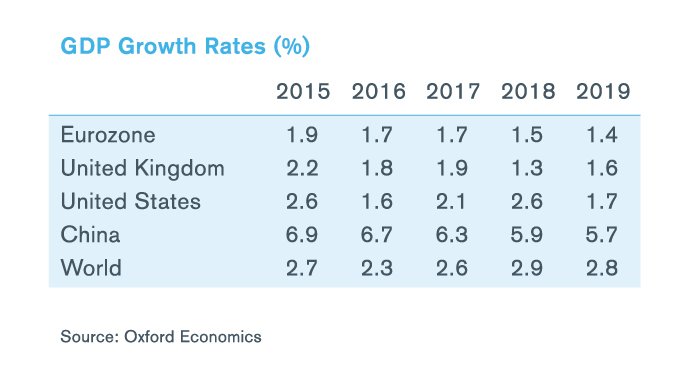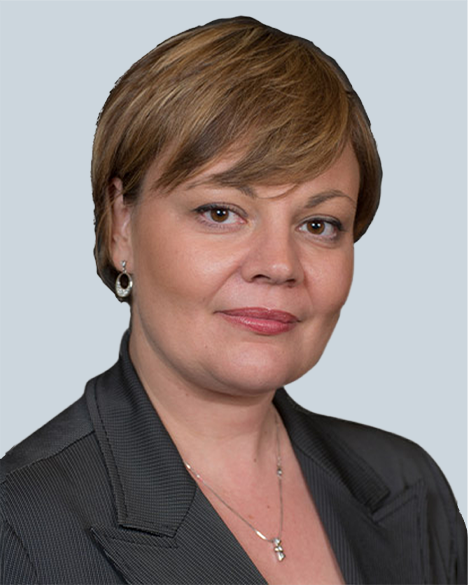This article was contributed by Andrea Boltho, Duff & Phelps Real Estate Advisory Group (REAG) Advisory Board Member and Emeritus Fellow, Magdalen College, University of Oxford.
The world economy seems to have shrugged off the political shocks coming from Brexit and from the American Presidential election. Activity is growing at a moderate but steady pace in both the UK and the US. More importantly, this is also happening in the wider world. East Asia is seeing continuing and relatively rapid expansion in China as well as a resumption of (admittedly only modest) growth in Japan. Both Brazil and, especially, Russia are coming out of their deep recent recessions and the Eurozone seems finally to have reached its cruising speed. Not since 2010-11 has the world seen such a coordinated and, so far, smooth upswing.
As was hinted at in the last quarterly note, this improvement in the global picture owes a lot to economic policy. Monetary policy has now been accommodating in the major economies for several years. Economic history shows that if interest rates are kept at low, or even negative, levels year after year, this is bound to eventually lead to a revival of demand, be it by consumers and/or by companies. In Europe, in addition, fiscal policy has, if not abandoned, at least moderated its obsession with austerity and this too has contributed to the revival which the Eurozone is seeing. It is true that a gradually more restrictive monetary policy has been announced in America and a similar swing is also likely in Europe over the longer term. The expected tightening in both areas are, however, likely to be relatively modest, given that inflationary pressures are still very subdued, especially in Europe. Inflation is also relatively low in many emerging markets and this adds to the world’s favorable picture.
There are, however, two major uncertainties. The first one concerns the United States. Much of Trump’s economic program remains clouded in uncertainty. This is particularly true in the area of international trade. So far there has been virtually no increase in US protectionism, but the danger of a shift into that direction lurks in the background given Trump’s past (but also more recent) pronouncements and the views of some of his close advisers. Restricting US imports (or subsidizing US exports), let alone slapping huge tariffs on some countries’ goods, could easily lead to tit-for-tat retaliation or even trade wars, cooling the present world-wide recovery. As far as domestic policies go, the administration has promised both sweeping deregulation and large tax cuts, but the failure to repeal so-called Obamacare has weakened Trump’s position in Congress. Hence putting words into action may take longer than initially expected. The growth upsurge such policies might conceivably unleash may have to wait for 2018 or 2019.
The second uncertainty concerns the emerging world. Over the last few years, while U.S. interest rates were very low, companies in emerging markets borrowed extensively in dollars. U.S. interest rates have now risen and are expected to rise further in the course of the year. In the past, such developments led to large outflows of capital from the developing world and to growing difficulties in servicing debt, given a concomitantly rising dollar. An immediate consequence, seen, for instance, in the course of 2013, when markets first anticipated a rise in US interest rates, was a sharp fall in many currencies, prompting monetary tightening at home. So far this year, none of this has happened. If anything, several emerging currencies have strengthened against the dollar. It remains to be seen whether this can last, but, for the time being at least, it helps the ongoing upswing in the developing world.
Turning to Europe, current indicators suggest some moderate strengthening. This is most apparent in Eastern Europe, where growth continues at a sustained pace. Some slowdown is possible in the UK, following the real income erosion induced by the pound’s depreciation, but this is unlikely to be major. As for the Eurozone, the specter of deflation seems to have been exorcised. Core inflation remains low, but it is no longer negative. Surveys of expectations in the manufacturing sector have shown increasing buoyancy (even if consumer confidence remains relatively subdued). Bank lending to companies continues to expand at a moderate pace. All in all, the outlook is becoming more positive and the area should grow at some 1½ per cent per annum over this year and next, with Spain and, possibly, Germany doing significantly better and Italy somewhat worse, in line with developments over the recent past. This is hardly spectacular, but still an improvement on the ½ per cent annual growth recorded between 2010 and 2016 (excluding 2015, when growth was artificially boosted by Ireland’s 26 per cent rate of expansion).
As in America, the major uncertainty surrounding the European picture is of a political nature. Populism created electoral surprises in the UK and in the US and this could also happen in the Eurozone. The results of the Dutch elections did not hand power to Geert Wilders but he did, nonetheless, garner a significant share of the vote. A similar outcome (i.e. no populist victory but a strong result) is expected for the French election, at least according to the polls. Should, however, the polls be wrong (as they have been on a number of recent occasions), economic activity would almost certainly suffer, and not just in France, from the massive uncertainty that a Le Pen presidency would create. A worrying outcome is also possible in Italy where elections will have to be held by February 2018 at the latest. At present the polls suggest that the 5 Star Movement could win the most votes. This is a party with virtually no experience of government; it is also skeptical about the euro and wants a referendum on Eurozone membership. Here too increased uncertainty about a possible “Ixit” could nip in the bud Europe’s recovery.

Stay Ahead with Kroll
Valuation Services
When companies require an objective and independent assessment of value, they look to Kroll.
Valuation Services
When companies require an objective and independent assessment of value, they look to Kroll.
Real Estate Advisory Group
Leading provider of real estate valuation and consulting for investments and transactions.
Corporate Restructuring and Debt Advisory
Turnaround, restructuring and insolvency services primarily to the mid-market sector
